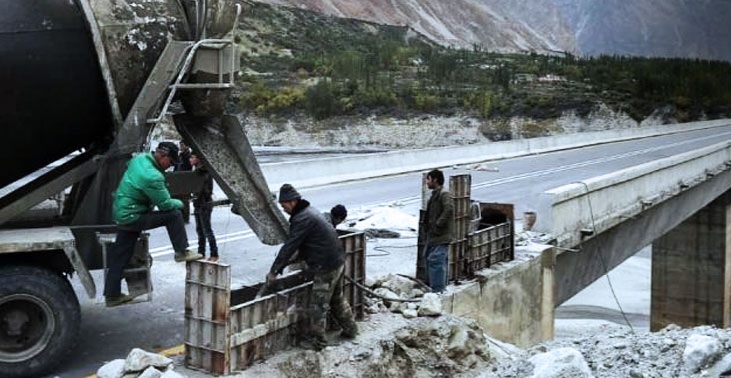The outlet, citing two sources with knowledge of the matter, reported that the project was on the agenda of the national security advisers of the four countries who met in Saudi Arabia on Sunday.
The White House had earlier said that Jake Sullivan, the White House’s national security adviser, was scheduled to travel to Saudi Arabia on Saturday to discuss bilateral relations and other regional issues of mutual interest with the kingdom’s officials.
Countering China’s influence
The US push to boost India’s foothold in the Persian Gulf at a time when Washington in order to focus more on containing China has moved towards reducing its presence in the West Asia and increasing its role in East Asia is actually an action for hindering the increasing role of Beijing in the geostrategically significant and oil-rich region of Persian Gulf, especially that Beijing has taken a long step to strengthen its position in the Persian Gulf by playing an effective role in the historic agreement between Iran and Saudi Arabia and also by inking strategic cooperation agreements with important regional actors.
According to analysts, this project is one of the US’s main initiatives in West Asia to replace China’s ambitious Belt and Road Initiative.
The initiative idea of the project was raised in a I2U2 (India, Israel, UAE, US) meeting held last month.
The bloc was formed in 2021, with its aim discussing strategic infrastructural projects in West Asia.
It is noteworthy that Road and Belt Initiative is a Chinese initiative resting on the lines of the ancient Silk Road, a major trade route that for centuries connected China to West Asia. The initiative is meant to link China to Europe through billions of dollars in investment on infrastructures of partners states. It is described as the human’s biggest infrastructure project that rests on construction of ports, roads, railways, industrial zones, and energy projects.
“The Road and Belt initiative represents a new global competition between the US and China,” National Interest described the Chinese project in an article.
According to experts, the White House thinks that India is an ambitious actor suitable to make a rival to China from. New Delhi has continuous relations with Washington which considers it a natural ally to counter China’s threat on the world stage. Also, Indians have close and growing economic relations with Saudi Arabia and the UAE, and in addition to the high demand for buying energy from these countries, it also competes with China in the field of economic cooperation with Persian Gulf states. Before the Ukraine war, India was the buyer of a significant part of the oil produced in the region, though now it meets part of its needs through discounted Russian oil. According to the data, OPEC’s share in India’s oil imports fell to an all-time low of 46 percent in April. At one point in the past, OPEC supplied 90 percent of India’s total crude oil, but this has declined since Russian oil became available at a discount. However, India will remain heavily dependent on the Persian Gulf for its future energy needs.
It should not be forgotten that despite this change, India remains the major exporter of consumer products and labor force to West Asia. The country holds friendly relations with both India and the UAE, and their bilateral trade agreements are growing. India’s exports to the UAE between April 2022 and March 2023 exceeded $31 billion, an increase of 11.2 percent over the same period last year. In February last year, the UAE signed a strategic partnership agreement with India, paving the way for a new era of cooperation and increasing mutual access to markets and economic and investment opportunities. According to Abu Dhabi, the agreement prepares the ground for increasing non-oil trade to more than $100 billion within five years. After China, India is the second trade partner of the UAE, accounting for 9 percent of the Arab country’s foreign trade and 13 percent of its non-oil exports.
A couple of months ago, the UAE unveiled a futuristic plan for rapid connection of the Persian Gulf to India through an underwater high-speed train starting from Fujairah, which overlooks the Gulf of Oman and thus Indian Ocean, to Mumbai, India’s biggest city.
In addition to the UAE, Saudi Arabia is increasing its trade with India. Last year, DP World, one of the world’s largest port operators, and the Saudi Ports Authority signed an agreement to build a new logistics sector at Jeddah Islamic Port with a total investment of more than $133.33 million.
The new sector enables link of the big Saudi port to Turkey, Indian Peninsula, Africa, and West Asia. The two Indian ports of Karachi and Mundra are part to this plan.
Washington’s initiative to revive normalization aimed at furthering Arab-Israeli economic entanglement
Though Israel is not part of the new initiative, the US is trying to push forward the grounded Arab-Israeli normalization project through expanding the economic entanglement of the regional countries with Tel Aviv. Meanwhile, the recent initiative makes a good choice to realize this aim.
Axios writes that Israel is currently not part of the initiative, but should the efforts to reactivate normalization make progress, it can join it in the future.
According to an Israeli official who joined the negotiations, in the I2U2 meetings of last year, Tel Aviv raised an idea with an aim of using Indian experience in the infrastructural megaprojects and the Biden administration expanded this idea.
In his speech at the Washington Institute for Near East policy on Thursday, Sullivan pointed to this initiative. He said one of the pillars of Biden’s strategy in West Asia is regional integration.
“A more integrated, interconnected Middle East empowers our allies and partners, advances regional peace and prosperity, and reduces the resource demands on the United States in this region over the long term without sacrificing our fundamental interests or our involvement in the region,” Sullivan was quoted as saying./129

